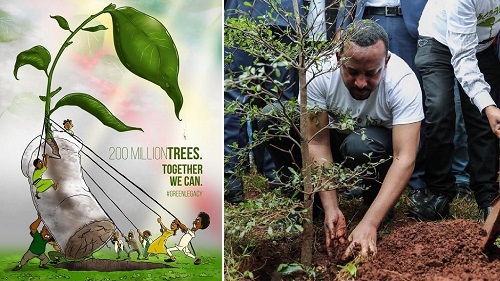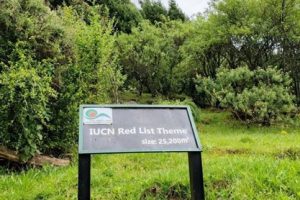
BY MENGESHA AMARE
The world over has drawn important lessons from Ethiopia as its citizens left their legacy in greening environment hand in hand with electing their representatives. All electorate have been stringently complying with the green legacy principles and planted trees after casting votes.
Ethiopians are day in and day out working to make the vision ‘Let’s adorn Ethiopia’ a reality. The very manifestation for this can be their commitment to firmly follow the green legacy launched by Prime Minister Abiy Ahmed (PhD). A number of tree seedlings have been planted as part of the 6 billion tree seedlings planned to be planted this year.
Interestingly, Ethiopia has committed to provided neighboring counties with over a billion tree seedlings to further reinforce its efforts of greening the Horn and the continent as a whole. If the initiative Ethiopian prime minister is well intensified and put into actions in all nations of the continent as well as the planet, abating the impacts of global warming can be at our doorsteps. Honestly speaking, Ethiopia’s move towards greening environment is a clear manifestation of its commitment to make Africa green in particular and share the burden of the universe in a bid to fight against global warming.
No one can deny that Ethiopia is highly endowed with mesmerizing ecological texture ranging from low land areas to the summit of the sea level. Between these area ranges there are a multitude of ecological spheres encircled in low land, highland, semi highland and even cold zone. In simple terms, Ethiopia is bedecked with every topographical fixture from the peak of Ras Dashen to the Afar extreme lowland.
All these splendid environmental topographies and compositions of fauna and flora have to be well taken care of with a view to helping the nation foster transformation. As the repercussions of land degradation as a threat of desertification have amplified the urgency of addressing the challenges of lack of green scenario and environmental degradation, the nexus between environment and green economy imitative has to be well consolidated.
The consequences of the environmental degradation and environmental policies of the country have to be made compatible to enhance the health, income and wealth, work and job quality, and safety of citizens in particular and pushing the country forward to be able to confidently combat environmental degradation thereby contributing its share to the effort geared towards containing global warming.
True, the benefits and costs of environmental policies are also likely to be unevenly distributed across nations, places, societies and even households. Hence, policy packages for an inclusive green transition should be framed in the way aims at mitigating the possible regressive impact of pricing environmental externalities, investing in human capital and upgrading skills to facilitate labor reallocation, addressing systemic inequalities with sectorial and place-based policies and ensuring efficient and responsive governance.
Therefore, an effective framework to measure progress towards a people-centered green recovery, and possible areas of future work, needs to be well fortified.
Yes, Ethiopia is doing all its best to make all areas green as much as possible thanks to the visionary leaders of the country ranging from the Premier. The move ignited by the Premier has now been in a position to be a culture of the society and is believed to be annually practiced. For instance, the mega projects commenced nationwide such as Gorgora, Wonchi and Koisha do have a wide array of greenery ventures in and at their vicinity. Understanding that nurturing nature highly pays off, all the initiatives and projects undertaken in Ethiopia mainly target at environmental safety and topographic beauty.
The green moves of the society are intended process guidelines recommending transparency and disclosure and promote integrity in due course of expanding green legacy. The initiatives commenced by the Premier with a theme ‘Let’s adorn Ethiopia’ with green blanket and they potentially provide the nation with opportunities to entertain credible green bond thereby transforming green economy.
The green legacy has attracted all walks of life including investors, banks, placement agents, companies, among others, to do all their level best for covering Ethiopia green.
Without a shadow of doubt, green growth has provided the country with a practical and flexible approach for achieving concrete, measurable progress across its economic and environmental pillars taking full account of the social consequences of greening the growth dynamic of economies. Ethiopia’s focus of green growth strategies is ensuring that natural assets can deliver their full economic potential on a sustainable basis.
Making areas green helps people get critical life support services via availing clean air and water, and the resilient biodiversity needed to support food production and human health.
Ethiopia is making ‘greening land’ its citizens’ culture. That is why whenever summer season sets in, everyone thinks over tree plantation. However, this sacred activity shouldn’t be carried out following a campaign fashion; instead it has to be a well-entrenched philosophy that has to be transferred from generation to generation.
Sightseeing the fragrance of greenery is by itself a magnet that always attracts citizens to nurture nature. To this end, Ethiopia has wholeheartedly capitalizing on green legacy. Green growth policies have to be an integral part of the structural reforms needed to foster strong, more sustainable and all-encompassing growth. Cognizant of the fact that green march can reduce vulnerability to environmental risks and increase the livelihood security of citizens, Ethiopia has been well entertaining tree seedlings plantation even during the Election Day.
Undeniably, greening the growth path of an economy depends on policy and institutional settings, level of development, social structures, resource endowments, environmental fitness, societal awareness and geographic compatibility.
It is demonstrated that an effective way to promoting economic development is to stimulate scientific and technological innovation and cultivate high-end talents and improve regional teamwork, which can reduce the negative effect of environmental protection on economic development. It is also necessary to enhance the positive impact of environmental protection on economic development by transforming the mode of economic development, developing the environmental protection industry, and raising people’s awareness of environmental protection. That is why Ethiopia would like to intensify its tree seedling project under the umbrella of ‘Green legacy.’
The chosen paths of development, though, are not always suitable to developing countries such as Ethiopia since they base their development policy on the paradigm set by the market economy.
Most environmental problems occur in public spaces, such as water or air, and it is therefore somewhat difficult to determine culpability. Ethiopia, as the custodian of public places and resources, is responsible for maintaining the integrity of public resources. Besides, environmental problems are often transnational in nature and, as a result, fall under international law, which is the law between states and other actors on the international plane. This therefore implies that the obligation of protecting the environment lies at the level of the state.
All nations of the world are expected to follow Ethiopia’s suit to promote green legacy and contribute their respective share to the effort geared towards combating global warming.
In a nut shell, planting trees is a legacy for us, a loved one, and the entire planet. Each drop of tree stands for another year to make a difference. People have to do this with a view to creating wildlife corridors with native trees, nurturing the mix of natural regeneration and tree planting as well as rescuing the earth from vanishing. Hence, every country following Ethiopia’s promising move has to plant trees, conserve thousands of hundreds of unique species of native trees, fruit trees, nesting trees, pioneer species and other floral species. Importantly, Ethiopia has capitalize on greening environment via inculcating this culture in the minds of the community, arduously working towards restoring the lost forests and heap on green legacy across the nation.
The Ethiopian Herald July 4/2021





